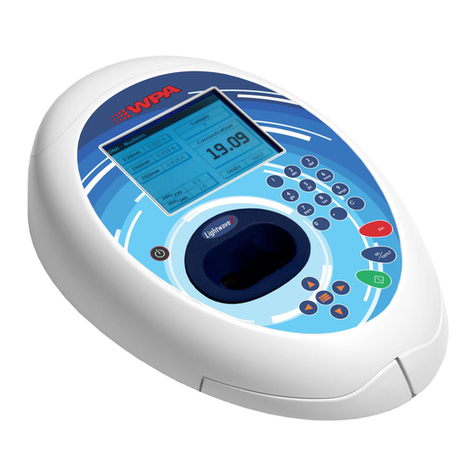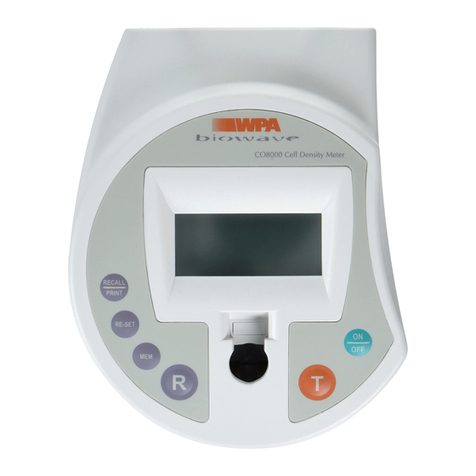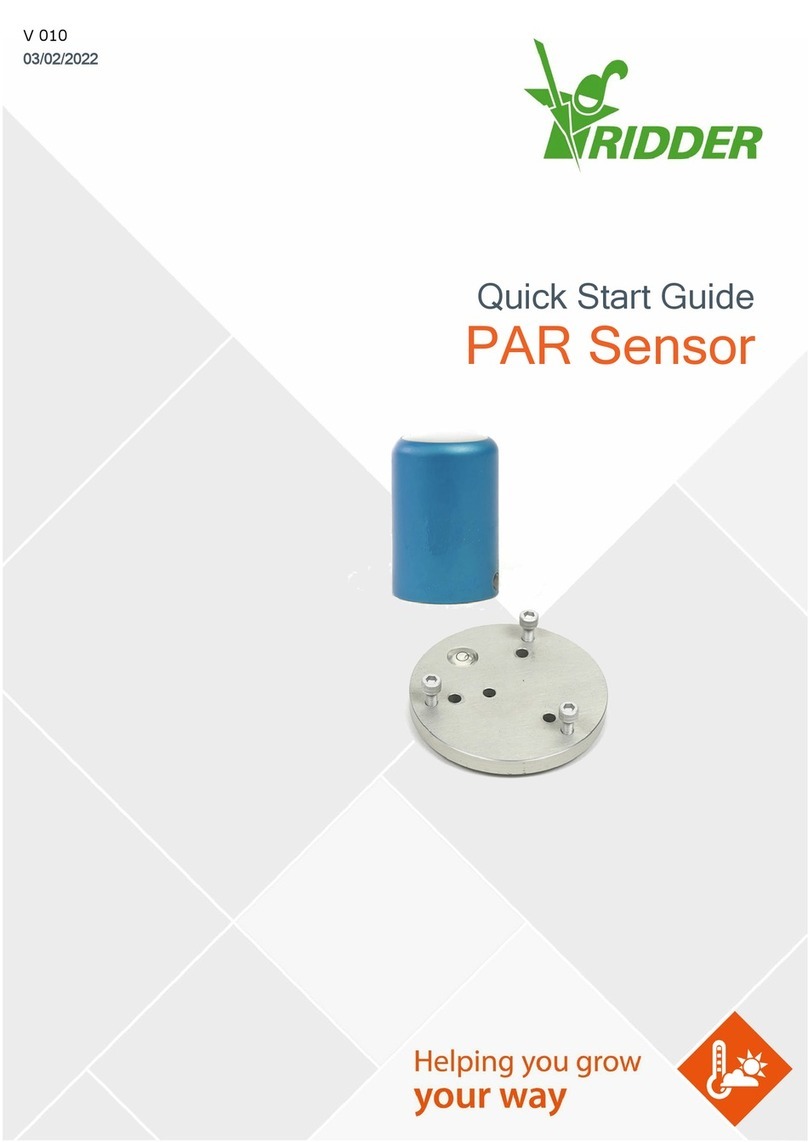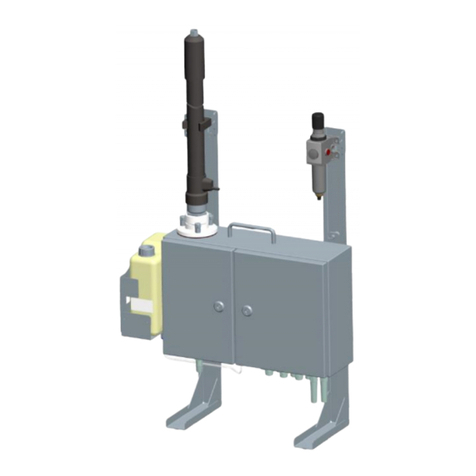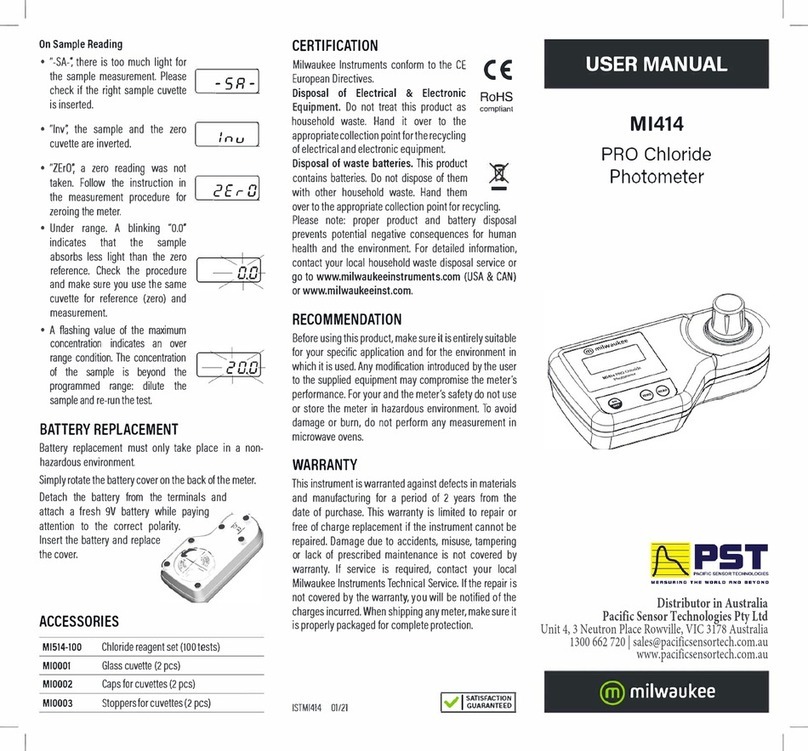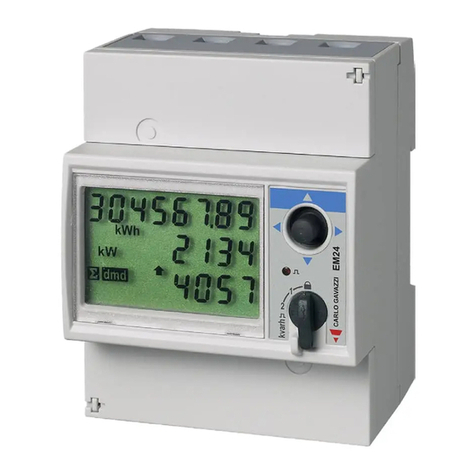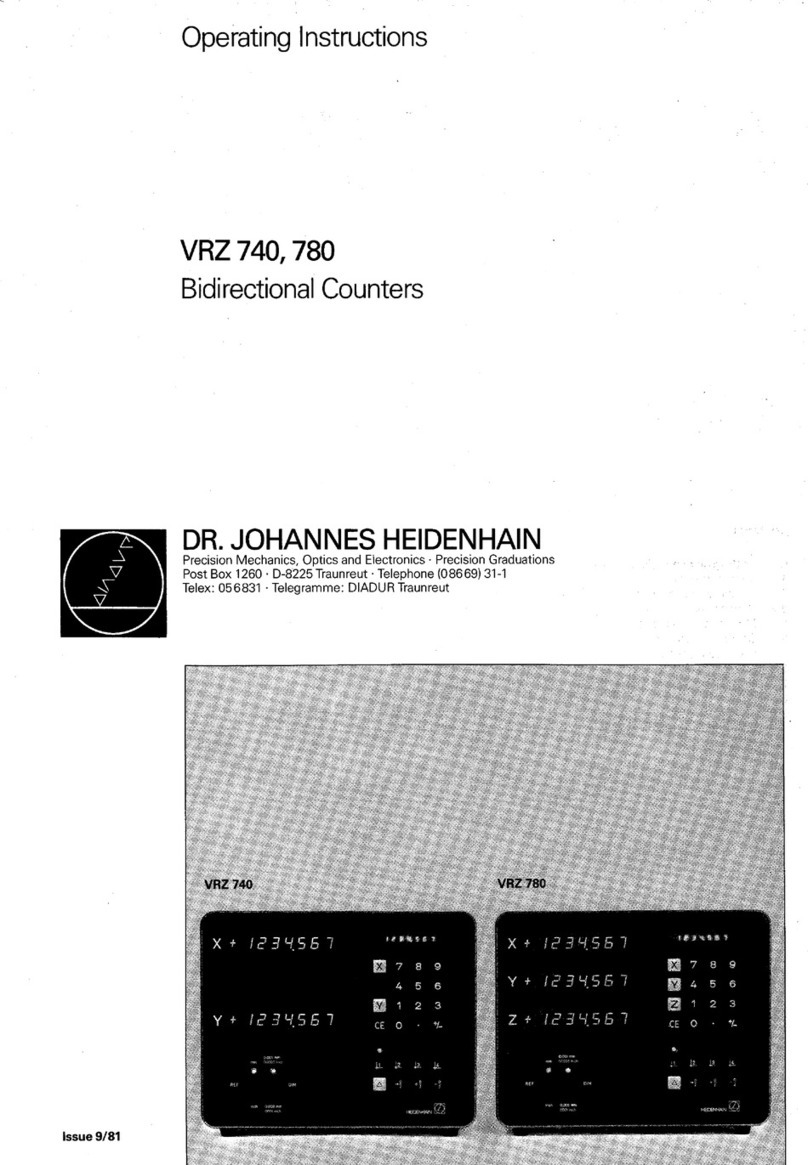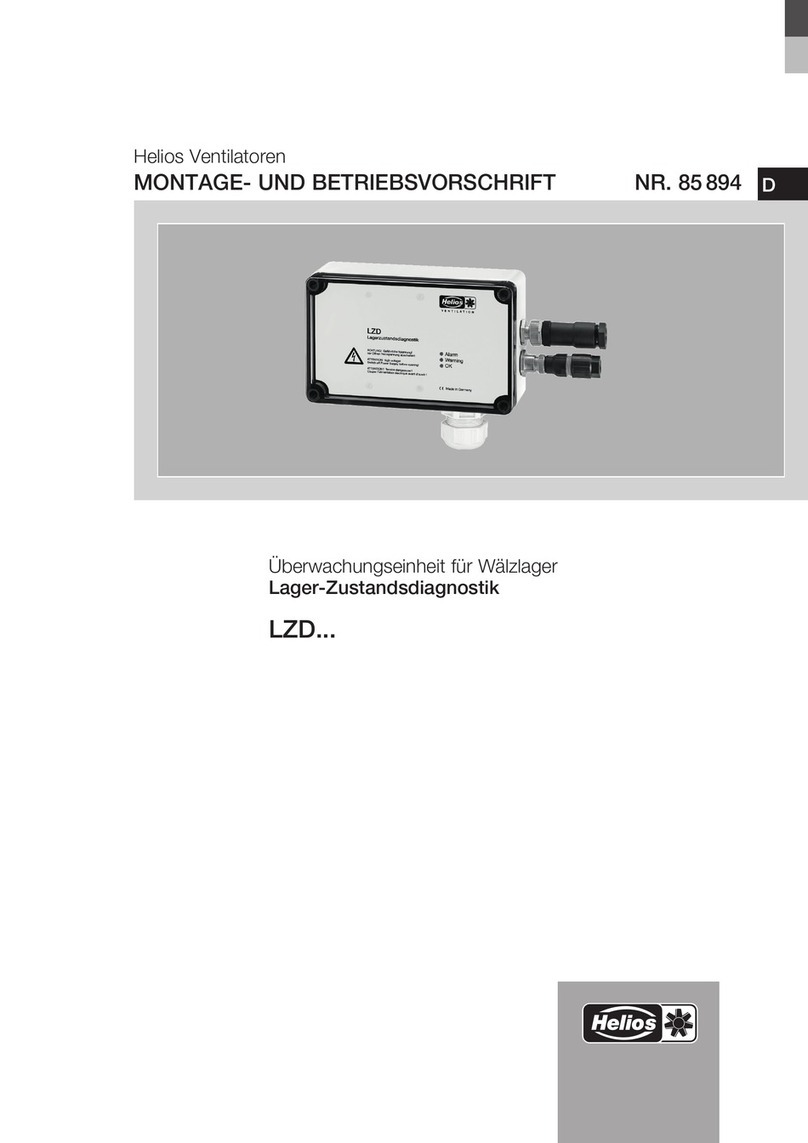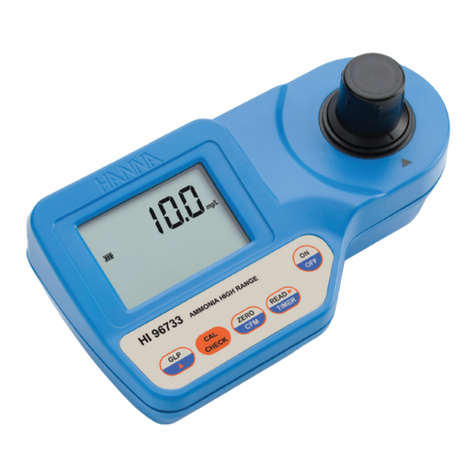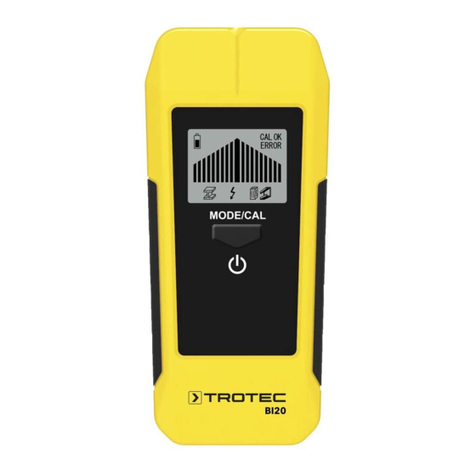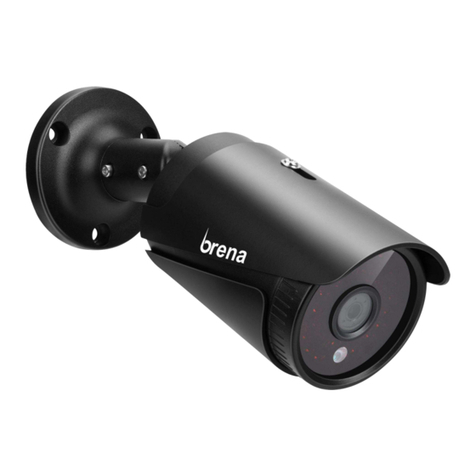WPA biochrom Biowave S2100 User manual

Instructions for
Biowave S2100
UV/Vis Diode Array
Spectrophotometer
Biochrom Ltd
22 Cambridge Science Park
Milton Road
Cambridge
CB4 0FJ, UK
Tel: +44 (0) 1223 423723
Fax: +44 (0) 1223 420164
Email: enquires@biochrom.co.uk
Website: www.wpaltd.co.uk

2
Declaration of Conformity
This is to certify that the WPA Lightwave S2100: 80-3000-73
manufactured by Biochrom Ltd. conform to the requirements of the following
Directives-: 73/23/EEC & 89/336/EEC
Standards to which conformity is declared
EN 61 010-1: 2001
Safety requirements for electrical equipment for measurement, control
and laboratory use.
EN 61326: 1998
Electrical equipment for measurement, control and laboratory use –
EMC requirements
Signed: Dated: 14th January 2003
David Parr
Managing Director
Biochrom Ltd
Postal address Telephone Telefax
Biochrom Ltd +44 1223 423723 +44 1223 420164
22 Cambridge Science Park
Milton Road e mail: enquiries@biochrom.co.uk website: http://www.biochrom.co.uk
Cambridge CB4 0FJ
England
Registered in England No: 974213
Registered Office: 22 Cambridge Science Park, Milton Road, Cambridge CB4 4FJ, England.
Biochrom Ltd
Certificate No. 890333

3
CONTENTS
1 INTRODUCTION............................................................................................................................................................................. 4
2 CONDITIONS OF SERVICE........................................................................................................................................................... 4
3 PRINCIPLE OF OPERATION......................................................................................................................................................... 5
4 SPECIFICATIONS........................................................................................................................................................................... 6
5 CONTROLS......................................................................................................................................................................................... 8
6 CUVETTE CHAMBER .................................................................................................................................................................... 9
7 INSTALLATION & START-UP...................................................................................................................................................... 10
8 GENERAL OPERATIONS............................................................................................................................................................. 12
8.1 REFERENCING...........................................................................................................................................................................12
8.2 MEASUREMENT AT LOW LEVELS (<0.050A).................................................................................................................................12
8.3 DILUTION .................................................................................................................................................................................. 12
8.4 BACKGROUND ABSORBANCE CORRECTION .................................................................................................................................13
9 SOFTWARE OPERATION............................................................................................................................................................ 14
9.1 NUCLEIC ACIDS.........................................................................................................................................................................14
9.1.1 dsDNA, ssDNA, RNA.................................................................................................................................................14
9.2 PROTEIN METHODS ...................................................................................................................................................................16
9.2.1 Colorimetric Protein methods..................................................................................................................................... 16
9.2.2 Direct UV Absorbance determination of Proteins ...................................................................................................... 20
9.3 CELL DENSITY MEASUREMENT....................................................................................................................................................21
9.4 OTHER......................................................................................................................................................................................22
9.5 SINGLE/MULTI λ........................................................................................................................................................................22
9.5.1 Single measurement................................................................................................................................................... 22
9.5.2 Multi Wavelength........................................................................................................................................................ 23
9.6 SCANNING.................................................................................................................................................................................24
9.7 OTHER METHODS ...................................................................................................................................................................... 25
9.7.1 To Program a New Method (or re-program an existing method)............................................................................... 25
9.7.2 Run a Method.............................................................................................................................................................31
10 INSTRUMENT SET-UP ................................................................................................................................................................ 33
10.1 SET CONSTANTS.................................................................................................................................................................33
10.2 COMMUNICATIONS...............................................................................................................................................................34
10.3 SET TIME/DATE................................................................................................................................................................... 35
10.4 AUTO-PRINT....................................................................................................................................................................... 35
11 PRINTING..................................................................................................................................................................................... 36
12 CONNECTION TO PC .................................................................................................................................................................. 37
12.1 SETTING UP THE BIOWAVE TO A PC LINK .............................................................................................................................. 37
12.2 USING THE BIOCHROM DATA CAPTURE SPREADSHEET INTERFACE SOFTWARE
(80-2112-23).............................................................................................................................................................................37
13 SERVICING AND MAINTENANCE............................................................................................................................................... 38
13.1 REPLACING THE LAMPS........................................................................................................................................................38
13.2 ROUTINE MAINTENANCE ...................................................................................................................................................... 39
13.3 DECONTAMINATION .............................................................................................................................................................39
13.4 CALIBRATION ...................................................................................................................................................................... 39
14 CE MARKING ............................................................................................................................................................................... 40
15 GUARANTEE................................................................................................................................................................................ 40
16 HEALTH & SAFETY CERTIFICATE AND DECLARATION OF DECONTAMINATION STATUS ............................................... 41
APPENDIX 1 – CALCULATIONS.............................................................................................................................................................. 42
NUCLEIC ACIDS......................................................................................................................................................................................42
PROTEIN UVABSORBANCE METHOD .......................................................................................................................................................43
BACKGROUND ABSORBANCE .................................................................................................................................................................. 43
16.1 OTHER METHODS ................................................................................................................................................................43
APPENDIX 2 -CONNECTING TO HYPERTERMINAL AND DOWNLOADING RESULTS...................................................................... 44

4
1 Introduction
The Biowave is a diode array UV/Vis spectrophotometer that has been
specifically designed for the Life Sciences and biotechnology market.
Popular methods are pre-programmed into the instrument for ease of use.
The Biowave spectrophotometer also offers: -
•Instantaneous scanning
•No moving parts
•Open sample compartment
•Space saving shape
We believe that the Biowave spectrophotometer will give many years of
trouble free operation. We do however recommend that you read this manual
prior to use.
We welcome any comments you may have regarding either the product or
this manual. Please contact: -
Sales and Marketing Co-ordinator
Tel: +44 (0)1223 892688
Fax: +44 (0)1223 894118
2 Conditions of Service
The Biowave spectrophotometer is intended for use under cover at a
temperature of between 5 and 40°C.
If dangerous or aggressive chemicals are used, care should be taken to avoid
spillage. Normal precautions should be taken against contact with all
samples used, some of which may be harmful.
The following parts are user replaceable: -
Cat No
Tungsten Lamp S2000T
Tungsten & Deuterium Lamp
Assembly S2000L
As for S2000L but accepting
old unit in part exchange S2000LX
Fan FA074

5
Cuvette Holder CS003
For other problems please contact our sales office or local authorised dealer
in your region.
Health & Safety Notice
Instruments will only be accepted for repair or re-calibration when
accompanied by a signed letter or certificate from the sender to the
effect that there is no hazard to health due to biological, chemical or
radioactive contamination. A copy of this certificate can be found on
the base of the unit or at the end of this manual.
3 Principle of Operation
The optical layout comprises a concave grating and 512 pixel diode-array.
On making a measurement both lamps (Deuterium and Tungsten) flash
consecutively. A self-regulating circuit ensures flash to flash repeatability.
The data for each wavelength is recorded and stored in memory. Stray light
is minimised by positioning the diffraction grating after the cuvette
compartment, thereby eliminating the need for a light cover.
The use of a diode array detector allows simultaneous measurement across
all wavelengths (scanning), and involves no moving optical parts, thereby
minimising maintenance costs.
A simplified optical layout is presented below: -
∗
∗
The added advantage of the above optical arrangement is that Stray
light is minimised, thereby eliminating the need for a cover over the
cuvette chamber.
Diffraction
grating
512 pixel
Diode Array
Light sources
Beam Splitter
Cuvette
Slit

6
4 Specifications
Specification S2100 Biowave
Optical arrangement Single beam, diode-array (512 pixel) using Rowland
Circle optics with flat field corrected concave
grating.
Wavelength range 200 –820nm
Spectral bandpass 5nm
Resolution/Bandwidth 5nm
Stray Light <0.1% at 220nm NAI and 340nm NaNO2
Wavelength Accuracy ±1.5nm
Wavelength
reproducibility Better than ±0.6nm
Photometric modes Abs, %T, Concn, ∆Abs/min, ∆Abs*factor/min
Photometric range -0.3 - 1.999A
0 - 199.9%T
Photometric
Reproducibility ±0.002Abs (0 to 0.5Abs)
±0.007Abs (0.5-1.0Abs)
Photometric Accuracy ±0.003Abs (0 to 0.5Abs)
±0.01Abs (0.5-1.0Abs)
Slew rate Full spectrum measured simultaneously,
measurement time <5 sec
Zero stability ±0.003Abs/hour after 20min warm up
Noise ±0.001Abs at 0A 500nm

7
Specification S2100 Biowave
Preprogrammed methods ds DNA
ss DNA
RNA
Oligonucleotides
Protein: Bradford, Lowry, BCA, Biuret & UV
Cell density measurement
Modes of operation Scanning
Ratio (A260/A280 and A260/A230 )
Multi Wavelength
Absorbance
% Transmission
Concentration (linear least squares or Polynomial
curved calibration)
Kinetics
Programmable - up to 99 methods stored in battery
backed memory
Display 240 x 128 pixel dot matrix LCD
Output RS232 to WPA printer for text and graphics
RS232 ASCII for PC data logging
Light sources Pulsed Deuterium and Tungsten halogen lamps
giving life in excess of 15000 hours
Sample compartment 40mm pathlength. Accepts 10mm and 40mm
cuvettes, 15mm beam height, standard, semi-micro,
micro and ultra micro cuvettes with volumes down to
70µl
Dimensions (l x w x d) Approx. 380 x 140 x 275 mm
Weight 4.5kg
Electrical Requirements 90-250V 50/60Hz Max 100VA

8
5 Controls
5.1
Note: The arrow keys and REF and TEST buttons are only operational in
certain modes. When operational, symbols (R for Ref, T for Test, + arrows)
will appear in the bottom left hand corner of the display. Similarly the
Function keys on the left-hand side of the display are only operational when a
box appears.
Escape key
- takes the
user back
one step or
aborts
current
operation
Reference
key - zeros
the
instrument
Test key -
makes a
measurement
across all
wavelengths
Function
keys (1-4)
- select
function
identified
in box. Symbols
indicate
which keys
are
operative
Cursor keys allow
the user to
navigate the
screen

9
6 Cuvette Chamber
The cuvette holder has been designed to accommodate a variety of cuvette
sizes in an accurate and repeatable manner.
Note: It is important to align the square cuvettes to the far left-hand side
of the chamber. The alignment of the cuvette is important to ensure re-
producible readings.
10mm
pathlength
cuvettes
should be
placed here
40 mm
Cuvette
Chamber Layout

10
7 Installation & Start-up
Unpack the Biowave spectrophotometer and ensure that you have received
the following in good condition: -
S2100 Biowave Spectrophotometer
Power Lead
Starter pack of 10 disposable UV cuvettes
Dust cover
Instruction manual
Warranty Card
Place the unit on a level surface, insert the mains cable in the rear socket
and then connect to the electricity supply (90-250V 50/60Hz).
Switch the instrument on using the switch at the rear. The Biowave logo
should appear followed by a self-diagnostic screen as below:
Check that all tests are passed or contact our sales office/authorised dealer.
Warm Up Time
To allow the optical and electronic components to stabilise it is recommended
to allow a minimum of 10 minutes for the unit to warm up. For minimum drift,
leave the instrument for 45 minutes to 1 hour.
It is best practice to always take a reference measurement prior to making a
TEST, however the Biowave will remember the last reference until the unit is
switched off or re-referenced.
Lamp Failure
Failure of the lamps indicates either that there was a cuvette in the
compartment when the instrument was switched on (simply remove the
cuvette and Re-test) or that the lamp has failed, or has output too low for
good performance.

11
Failure of one lamp will not affect the other lamp - so if the Deuterium lamp
fails you can still make good visible measurements (380 to 825 nm).
See section on Servicing & Maintenance
Failure in Wavelength Calibration
The wavelength calibration is performed by observing the key spectral data
from the Deuterium lamp and ensuring that the peak remains in the correct
position. A failure in wavelength calibration infers some movement of the
fixed optical system or exposure to extreme temperatures.
Try leaving the unit on for a few minutes and then re-start.
If the failure re-occurs please consult your local dealer/service agent or our
service department.
Note: The unit will continue to operate despite being out of wavelength
calibration.
Failure of Diode Array
On start up the unit checks that all pixels (512) are operating. A failure of any
pixel will give the above error.
The unit can still be used as operation at other wavelengths will not be
affected. The faulty pixel will show itself as a line on the wavelength scan.
If the failure occurs please consult your local dealer/service agent or our
service department.

12
8 General Operations
8.1 Referencing
When R is displayed in the bottom left hand corner of the display, it is
possible to Reference the instrument by pressing REF.
The reference across all wavelengths will be held in the memory until the unit
is switched off, or re-referenced. However for best results, reference the unit
before each measurement is taken.
The reference material will normally be a low absorbing material, often the
solvent used with the sample, which is mostly water.
If the reference Absorbance is too high the instrument will display “----“
If this appears, first check the type of cuvette being used (Quartz for UV
measurements). If this is satisfactory consider an alternative reference
material.
8.2 Measurement at Low Levels (<0.050A)
Due to the narrow beam size needed for use with small volume cuvettes, the
Biowave is sensitive to variations in cuvettes and to scratches or dirt on the
inside or outside of the cuvette.
We therefore recommend using the same cuvette as both the reference to
measure the sample.
8.3 Dilution
Some methods contain a dilution factor.
This is to be used where samples are diluted prior to measurement. All the
screens work in a similar manner – with the up/down cursors being used to
change the value and the left/right cursors to select the digit to be changed. A
separate function button allows the decimal point to be changed.

13
The factor will be used as a multiplier for the value obtained.
E.g. If the user has diluted a sample 1:9 sample/diluent, the factor used will
10.000.
Concentration = 10.000 * Abs * Factor
Where the factor relates to the specific method.
8.4 Background Absorbance Correction
Some samples can be turbid and this can affect the readings obtained. The
Biowave contains the facility to correct for this by subtracting the Absorbance
at 320nm from the values taken at 260 and 280nm.
This correction facility has the symbol Acorr which will appear in the bottom left
hand corner of the screen when active. The correction facility can be applied
to all Nucleic Acid measurements and also to the direct UV Protein method.

14
9 Software Operation
After the spectrophotometer has performed the self diagnostics press the
Cont. Function Key to proceed to the first menu screen.
9.1 Nucleic Acids
This Function key displays the choice of Nucleic Acid methods pre-
programmed into the instrument.
Press the Function key for the desired sample type to bring up a further menu
which allows the user to enter the assay conditions.
9.1.1 dsDNA, ssDNA, RNA
All three methods work in a similar fashion, so for ease of representation only
the dsDNA is represented here.

15
The ratio readings give information about the purity of the sample. The
A260/230 reading give a measure of phenol contamination following
extraction.
The A260/280 ratio measures protein contamination.
9.1.1.1 Programming
The program button allows the units of concentration to be changed between
µg/µl, µg/ml and pmol/ml and the background correction to be turned on and
off using the appropriate arrow keys. Press Function Key 4 “All OK” to
proceed to the next screen.
If pmol/ml is selected then an additional line will appear for the No of Base
Pairs to be entered
For the concentration of Oligo’s in pmol/ml, instead of the calculation using
the number of bases, it uses the sequence of bases (see Appendix II for
details of calculation).
Pressing Change allows the No.of Bases to be entered using the cursor keys
in the normal manner (similar to Dilution Factor).

16
The Factor used in the calculations defaults to the values below:-
dsDNA 50.00 µg/ml
ssDNA 37.00 µg/ml
RNA 40.00 µg/ml
Oligo 33.00 µg/ml
These can be changed – see section 10.1
9.2 Protein Methods
This gives the user the option of the pre-programmed methods of:
•Protein BCA
•Protein Bradford
•Protein Lowry
•Protein Biuret
•Protein UV
A choice of 4 colorimetric protein methods are available + one direct UV
Absorbance method.
9.2.1 Colorimetric Protein methods
We have described the Bradford Assay, but the other assays work in an
identical fashion, with the wavelength and name changing.
The program button allows the units of concentration to be changed , and the
calibration between standard and factor to be selected .

17
9.2.1.1 Standard Calibration
If the factor of the calibration graph is not known, the calibration graph can be
constructed. “Standard” is chosen by using the ←→ keys and pressing
Function Key 4 “Accept”
On selecting set Standard, the number of replicates will then appear beneath.
The calibration values can then be input.
Pressing Set Std will allow the concentration of the standards to be input.
Press change to modify the standard value. The cursor keys allow the digits
to be changed - move to the next digit using ←→. Function Key 3 “……”
moves the decimal point by one space when pressed.

18
Press Accept to confirm. Once all the standard values are correct press
Function Key 4 “All OK”.
The cursor then moves to the first Absorbance entry for Std 1.
Absorbance values can be entered manually by pressing the Change button
and using the cursor keys, as for the standards, or directly, by placing the
appropriate standard in the cuvette chamber and pressing TEST (having first
taken a valid reference).
Upon entering the Abs value for the first standard (Abs1) , use the arrow keys
to move to the next replicate (Abs2)or to the next standard if only 1 replicate
is required. Ensure that for all standards selected there are Absorbance
values entered. The left arrow can be used to scroll across the screen
revealing the values entered for Abs1, Abs2and Abs3.
9.2.1.1.1 Curve fitting
On completion the choice of Curve fit can be made.
If the relationship between Abs and concentration is anticipated to be a linear
one, then select Linear Least Squares. This will create a best fit straight line
based on all the data points entered.
If the relationship is anticipated to be non linear, select Polynomial (curve).
This will attempt to fit a polynomial expression exactly to the points given.
The order of the polynomial depends upon the number of points chosen. For
2 points a straight line equation is selected eg:-

19
2 point : y = a + bx
3 point : y = a + bx + cx2
INVALID CURVES
Because the equation fits a curve exactly to the points, there is a chance that
the resultant curve is not valid. If the curve selected contains points of
inflection (where the slope changes sign eg maxima and minima) it would
give rise to potentially more than one Concentration for a chosen Abs value.
This is clearly unacceptable and therefore the program displays “Invalid
Curve”.
To overcome this we recommend that the number of points is reduced. If this
still fails it may be sensible to select Linear Least Squares.
Where replicates are being used, the unit takes an average value for each
standard.
To display the graph press Graph .
9.2.1.2 Factor Calibration
If the calibration for the method is already known, and represents a straight
line, then select Cal = Factor.
In this case a Factor will be displayed.
To change the factor, press Change and proceed as normal.

20
9.2.2 Direct UV Absorbance determination of Proteins
For a rapid, rough estimate of Protein Concentration the Direct UV method is
ideal. The method is based upon the Christian Warburg Expression (see
Appendix II) .
Pressing Program allows units, factors and background absorbance (A320)
status to be changed.
Table of contents
Other WPA Measuring Instrument manuals
Popular Measuring Instrument manuals by other brands
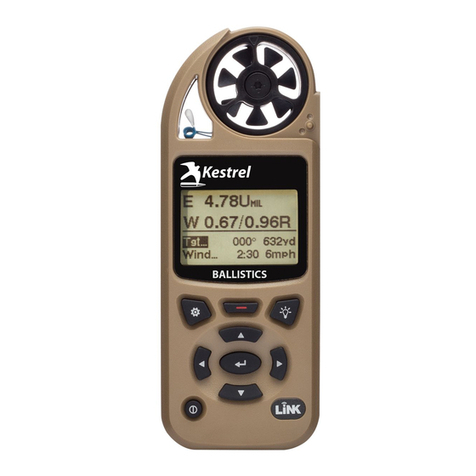
Kestrel Ballistics
Kestrel Ballistics 5700 Getting started
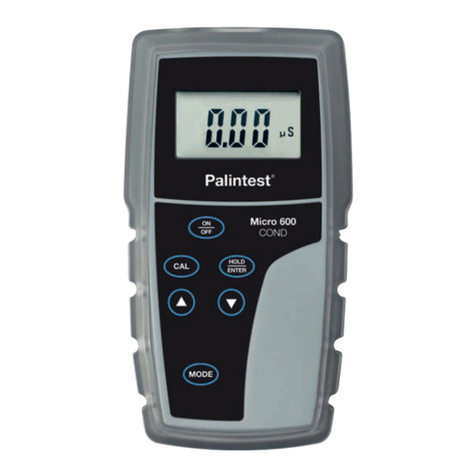
palintest
palintest Micro 600 COND manual
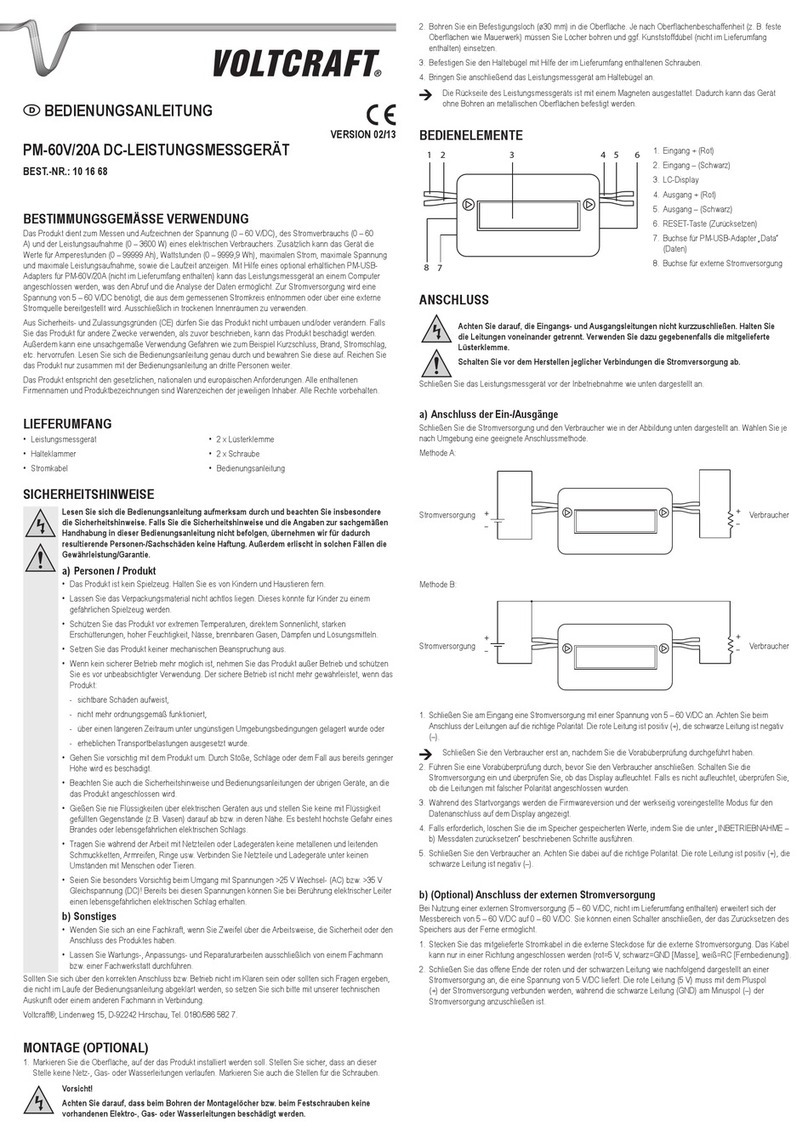
VOLTCRAFT
VOLTCRAFT PM-60V/20A operating instructions

MONARCH INSTRUMENT
MONARCH INSTRUMENT Pocket Laser Tach 200 instruction manual
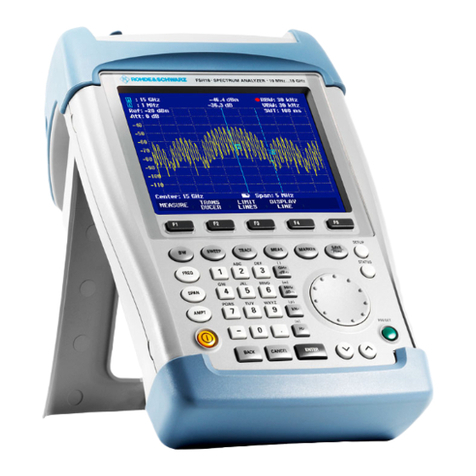
R&S
R&S FSH3 operating manual
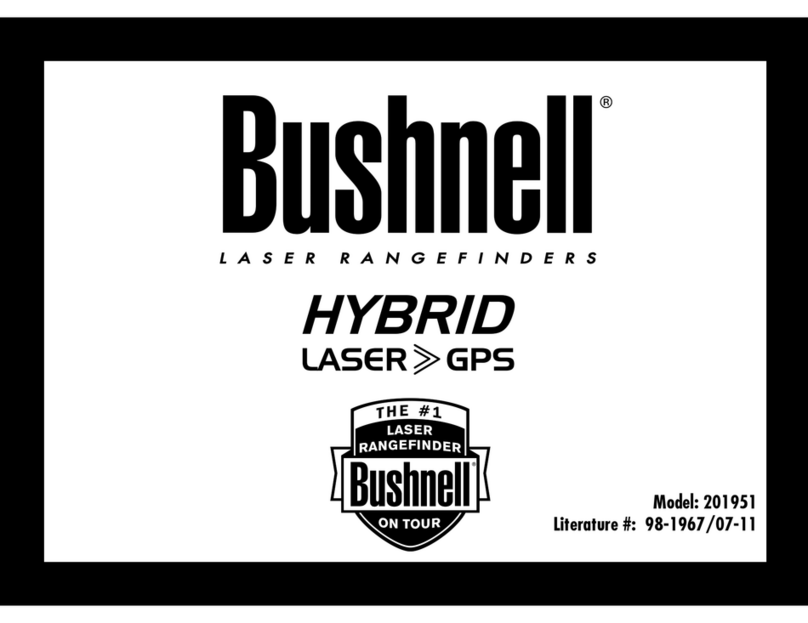
Bushnell
Bushnell Hybrid 201951 instruction manual
